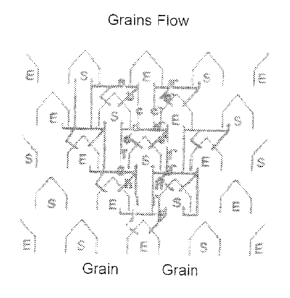Some of the information on this Web page has been provided by external sources. The Government of Canada is not responsible for the accuracy, reliability or currency of the information supplied by external sources. Users wishing to rely upon this information should consult directly with the source of the information. Content provided by external sources is not subject to official languages, privacy and accessibility requirements.
Any discrepancies in the text and image of the Claims and Abstract are due to differing posting times. Text of the Claims and Abstract are posted:
| (12) Patent: | (11) CA 2758408 |
|---|---|
| (54) English Title: | PERFORATED AIR-DUCT FOR GRAINS DRYING TOWER |
| (54) French Title: | CONDUIT D'AIR PERFORE DESTINE A UNE TOUR DE SECHAGE DU GRAIN |
| Status: | Granted |
| (51) International Patent Classification (IPC): |
|
|---|---|
| (72) Inventors : |
|
| (73) Owners : |
|
| (71) Applicants : |
|
| (74) Agent: | RICHES, MCKENZIE & HERBERT LLP |
| (74) Associate agent: | |
| (45) Issued: | 2018-06-12 |
| (86) PCT Filing Date: | 2010-04-15 |
| (87) Open to Public Inspection: | 2010-10-21 |
| Examination requested: | 2015-04-10 |
| Availability of licence: | N/A |
| (25) Language of filing: | English |
| Patent Cooperation Treaty (PCT): | Yes |
|---|---|
| (86) PCT Filing Number: | PCT/BR2010/000130 |
| (87) International Publication Number: | WO2010/118496 |
| (85) National Entry: | 2011-10-12 |
| (30) Application Priority Data: | ||||||
|---|---|---|---|---|---|---|
|
PERFORATED AIR-DUCT FOR GRAINS DRYING TOWER, referring to a
trough (1) in V form, made-up by two vertical lateral faces (2), united by two
converging superior faces (3), the faces being provided with a multiplicity of
openings (5), which reduce the grains column between the trough layers (1)
in the tower, which increases the drying speed because the grains thickness
is finer, consequently reducing the drying time.
L'invention concerne une goulotte (1) en forme de V constituée par deux faces latérales verticales (2) jointes par deux faces supérieures convergentes (3), lesquelles sont pourvues d'une pluralité d'ouvertures (5) permettant de réduire la colonne de grains entre les rangées de goulottes (1) dans la tour, la vitesse de séchage augmentant du fait de l'épaisseur de grains réduite, d'où une réduction importante du temps de séchage.
Note: Claims are shown in the official language in which they were submitted.
Note: Descriptions are shown in the official language in which they were submitted.

For a clearer understanding of the status of the application/patent presented on this page, the site Disclaimer , as well as the definitions for Patent , Administrative Status , Maintenance Fee and Payment History should be consulted.
| Title | Date |
|---|---|
| Forecasted Issue Date | 2018-06-12 |
| (86) PCT Filing Date | 2010-04-15 |
| (87) PCT Publication Date | 2010-10-21 |
| (85) National Entry | 2011-10-12 |
| Examination Requested | 2015-04-10 |
| (45) Issued | 2018-06-12 |
There is no abandonment history.
Last Payment of $347.00 was received on 2024-04-09
Upcoming maintenance fee amounts
| Description | Date | Amount |
|---|---|---|
| Next Payment if standard fee | 2025-04-15 | $624.00 |
| Next Payment if small entity fee | 2025-04-15 | $253.00 |
Note : If the full payment has not been received on or before the date indicated, a further fee may be required which may be one of the following
Patent fees are adjusted on the 1st of January every year. The amounts above are the current amounts if received by December 31 of the current year.
Please refer to the CIPO
Patent Fees
web page to see all current fee amounts.
| Fee Type | Anniversary Year | Due Date | Amount Paid | Paid Date |
|---|---|---|---|---|
| Application Fee | $400.00 | 2011-10-12 | ||
| Maintenance Fee - Application - New Act | 2 | 2012-04-16 | $100.00 | 2012-03-27 |
| Maintenance Fee - Application - New Act | 3 | 2013-04-15 | $100.00 | 2013-04-11 |
| Maintenance Fee - Application - New Act | 4 | 2014-04-15 | $100.00 | 2014-03-27 |
| Maintenance Fee - Application - New Act | 5 | 2015-04-15 | $200.00 | 2015-03-31 |
| Request for Examination | $800.00 | 2015-04-10 | ||
| Maintenance Fee - Application - New Act | 6 | 2016-04-15 | $200.00 | 2016-03-30 |
| Maintenance Fee - Application - New Act | 7 | 2017-04-18 | $200.00 | 2017-04-07 |
| Maintenance Fee - Application - New Act | 8 | 2018-04-16 | $200.00 | 2018-03-27 |
| Final Fee | $300.00 | 2018-04-24 | ||
| Maintenance Fee - Patent - New Act | 9 | 2019-04-15 | $200.00 | 2019-04-03 |
| Maintenance Fee - Patent - New Act | 10 | 2020-04-15 | $250.00 | 2020-04-01 |
| Maintenance Fee - Patent - New Act | 11 | 2021-04-15 | $255.00 | 2021-04-13 |
| Maintenance Fee - Patent - New Act | 12 | 2022-04-19 | $254.49 | 2022-03-22 |
| Maintenance Fee - Patent - New Act | 13 | 2023-04-17 | $263.14 | 2023-04-11 |
| Maintenance Fee - Patent - New Act | 14 | 2024-04-15 | $347.00 | 2024-04-09 |
Note: Records showing the ownership history in alphabetical order.
| Current Owners on Record |
|---|
| PACHECO DA CUNHA, OTALICIO |
| Past Owners on Record |
|---|
| None |